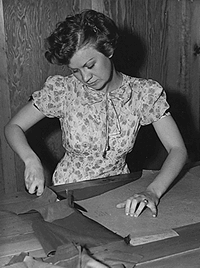Due to the 1929 stock market crash, and many other attributing factors, the United States entered into the Great Depression within the year 1929. As a result, the unemployment rate of men increased to 25%. Not only were men left to fend for themselves, but also the family members which they were responsible for.

Women Seeking Employment:
- Women and men had been socialized to see their roles differently: men were the breadwinners and women worked at home. However, when the Depression hit, men often became depressed and saw themselves as failures. Women, on the other hand, saw their roles increase and worked diligently to make ends meet.
- Of the female workforce, one-third of them were married. This is a fifty-percent increase from the 1920s.
- If women did not seek employment elsewhere, they would have used their own labor to account for what they would have previously purchased. For example, they would mend their own clothes rather than buying new ones.
- When Depression hit, women sought employment out of the house: nurses, school teachers, beauticians, cleaning ladies (maids/cooks), secretaries, and manufacturing occupations (sewing). According to the Censuses taken in 1930 and 1940, the number of women holding professional jobs increased by 20.

- Interestingly, hostility came from the women being hired outside of the homestead because the unemployment rate of men was equivalent to the employment rate of women. (The employment rate of women was 25.4% in the latter 1930s; the unemployment rate of men was 25%.) The hostile attitude is reflected in a quote by Norman Cousins, ?Simply fire the women, who shouldn?t be working anyway, and hire the men. Presto! No unemployment. No relief rolls. No depression.?
Discriminatory Laws Against Women Employment:
- During the Depression, 26 states had laws prohibiting the employment of married women. The mindset behind this derived from the married man being perceived as the breadwinner ? if the woman was employed, she was stealing a job from the man.
- Section 213 of the 1932 Federal Economy Act banned more than one family member from working for the United States government. This was aimed at diminishing the employment of married women.
- In 1932 and 1935, the Atlanta Board of Education proposed that schools disallowed their female teachers from being married, or that schools would refuse to hire married, female teachers.
- Twenty-five percent of the National Recovery Administration codes set lower minimum wages for women doing the same jobs as men. (In 1937, annual pay was $525 for women and $1.027 for men.)

- Roosevelt?s New Deal agencies gave employment almost entirely to men, especially in regards to Civilian Conservation Corps and Civil Works Administration. Because women were thought of as not being able to do manual labor, they were often placed in sewing rooms.
- Vast majority of social security benefits went to men and his dependent wife. This implied that women only deserved economic rights in relations to men, disadvantaging those who didn?t fit the traditional housewife mold.
For further research, check-out ?Quiet Suffering: Atlanta Women in the 1930s? by Julia Kirk Blackwelder. It clarifies how particular races of women were treated in the field of employment during the 1930s.
Resources Used:
-https://www.nwhm.org/online-exhibits/industry/12.htm (provided pictures and info)
http://ic.galegroup.com/ic/uhic/ReferenceDetailsPage/ReferenceDetailsWindow?query=&prodId=UHIC&displayGroupName=Reference&limiter=&disableHighlighting=true&displayGroups=&sortBy=&zid=&search_within_results=&action=2&catId=&activityType=&documentId=GALE%7CCX3468301237&source=Bookmark&u=sand55832&jsid=ff1c546a17b62d2d1ce4007351b97724

